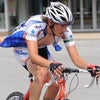ABSTRACT: It’s all about the pros. Sure, I may cheer harder for my buddy struggling to make the time-cut at an Ironman triathlon than for Contador when he’s on some Tour-winning attack, but I always tune into the race. Part of me wants to see the struggles, epic attacks, history made. But most of me just wants to ogle. As a cyclist, the Tour de France is my Sports Illustrated swimsuit edition. Some guys go for Kate Upton in a bikini on an Antarctic beach. My tastes are more restrained; I salivate over the best gear, newest tech, and latest approaches every July. And I justify my lust; it’s research! I’m turning to the pros in my chosen sport for advice. Mr. Bike Racer, how should I eat, when should I train, what should I look like on the bike? But what exactly—apart from genetics—sets them apart? Specifically, how do the pros eat, and should we be taking note?
The Explainer
⇢ Is There a Better, Faster Way to Train?⇢ Is Your Warm-Up Hurting Your Workout?
⇢ Why Kids Shouldn’t Focus on 1 Sport
HYPOTHESIS: Elite athletes eat highly-tuned diets that look nothing like our own.
METHODS: A recent study in the tracked 324 athletes—from a variety of backgrounds, endurance and otherwise—at eight Canadian Sport Centers. Athletes recorded what and when they ate as well as how often they trained.
RESULTS: Almost all athletes had three meals a day with a big chunk of their calories coming from breakfast. Getting into the details, 27 percent of their calories came from fat, 20 percent from protein, 55 percent from carbohydrates. They also had a tendency to snack: 57 percent of them ate a morning snack, 71.6 had an afternoon snack, and 58.1 had an evening snack. On days when they didn’t train, the were a bit less likely to snack—but they didn’t skip meals.
DISCUSSION: The pros are problematic. To understand why, think back to high school: Some of the A students didn’t even have to study to warp the curve. The same holds true with elite athletes. “They can get away with eating more fat and protein without an effect on their body composition or performance” because of their genes and training, says Stacy Sims, Ph.D., a sports physiologist, nutritionist at Stanford University, and co-founder of . While some elites have notoriously clean diets—think: Lance Armstrong and his scale—others did pretty well eating dirty, like Ryan Lochte until this Olympic cycle.
Our sample: They actually ate more protein than they needed and took in fewer carbs than they should have, says the study’s lead author, Kelly Anne Erdman, M.S.c, R.D., and Team Canada Dietician for the 2012 London Olympics.
So what can we learn? When it comes to the calorie-by-calorie breakdown between fat, carbs, and protein, the results aren’t too surprising, says Erdman. Just like elite athletes, recreational athletes are taking in too much protein, are pretty good on fat, but eat too few carbs, she says. They’ve fallen into the “carbs are evil” trap that a cursory adoption of gluten-free or low-carb diets can cause. (Note: Erdman says you absolutely can do well gluten-free, but it requires careful attention to getting in your carbs.)
So we’re not that different than the elites, after-all. That is, when we don’t take calories into account. Unlike the average couch potato, pros are self-regulating their calorie intake to match their activity level, and they’re consistently eating three meals a day, Erdman says. On days that they don’t train, they cut back on their snacking to make sure they’re not putting on weight. And in general, they’re getting only 24 percent of their calories from snacking. In contrast, the average American takes in 25 percent of his calories from snacks—with sugary beverages making up about half of the total, according to research presented at the Institute of Food Technologists Annual Meeting and Food Expo. The difference seems small, but it’s actually substantial. When a pro snacks, she’s pounding down a recovery drink to build muscle and aid recovery. When the average American visits the pantry, he’s going for chips and a soda. She’s building muscle, he’s fueling flab.
Snacking—in the form of recovery drinks or meals—after training is clearly beneficial, but at first glance, the frequency of snaking makes less sense. Look again, and things become clear: They’re snacking to control their body composition, says Erdman. “Slight adjustments to body composition make a difference in acceleration or aerodynamics,” she says. Some pros need to pack on the muscle, so they’re eating 20 grams of protein every three hours—which numerous studies show helps maintain muscle mass—and having a protein snack before bed to keep building muscle. Alternatively, someone who’s struggling to shed the pounds may forgo eating after dinner to create “a greater window of time where the body says fuel is not coming through and I better start utilizing fat reserves,” she says. Even a healthy snack—say, an apple—would boost blood sugar levels and mess with the burn.
But what about that big breakfast—aren’t we supposed to train on empty to boost our metabolism? It depends on your goals, says Sims. When you go out on empty, you burn more fat during your actual exercise session—possibly training your body to utilize this fuel in the future. But “if you’re using the body fat during your run, it’s an incentive to store more body fat” once you’re done, Sims says. While some athletes need to train this fat-burning, it isn’t an everyday approach. Without the sugar to fuel your run, you won’t be able to hit the high intensities needed to yield improvement.
CONCLUSION: There is no bottom line. Every athlete requires slight tweaks to his or her diet, but you can probably afford to consume more carbs, snack smarter, and eat a bigger breakfast.


